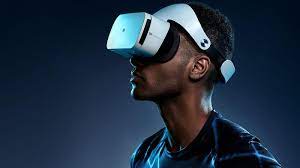 Currently virtual reality systems use either or multi-projected environments to generate some realistic images, sounds and other sensations that simulate a user’s physical presence in a virtual environment.
Currently virtual reality systems use either or multi-projected environments to generate some realistic images, sounds and other sensations that simulate a user’s physical presence in a virtual environment.
Virtual reality is the ability to look around the artificial world, move around in it, and interact with virtual features or items.
The effect is commonly created by VR headsets consisting of a with a small screen in front of the eyes, but can also be created through specially designed rooms with multiple large screens.
Virtual reality (VR) refers to a computer-generated simulation of an immersive and interactive environment that can be similar to or completely different from the real world.
It typically involves wearing a VR headset that tracks the user’s head movements and displays a realistic or fictional virtual environment to the user’s eyes.
VR can also include other sensory experiences like sound, touch, and even smell.
The goal of VR is to create a sense of presence.
The VR user feels like they are truly present in the virtual environment and can interact with it in various ways.
VR has applications in entertainment, education, training, gaming, therapy, and many other fields.
One method of virtual reality can be realized is -based virtual reality.
Driving simulators, giving the driver on the impression of actually driving an actual vehicle by predicting vehicular motion caused by driver input and feeding back corresponding visual, motion and audio cues to the driver.
Individuals can join the virtual environment in the form of real video as well as an avatar.
Projector-based virtual reality, plays a vital role in various virtual reality applications, including robot navigation, construction modeling, and airplane simulation.
Image-based virtual reality systems accurately register acquired 3D data; usually, a camera is used for modeling small objects at a short distance.
Desktop-based virtual reality involves displaying a 3D virtual world on a regular desktop display.
Many modern first-person video games use various triggers, responsive characters, and other such interactive devices to make the user feel as though they are in a virtual world.
A head-mounted display (HMD) more fully immerses the user in a virtual world.
A virtual reality headset typically includes two small high resolution monitors which provide separate images for each eye for stereoscopic graphics rendering a 3D virtual world, a binaural audio system, positional and rotational real-time head tracking for six degrees of movement.
Options include motion controls with feedback for physically interacting within the virtual world for more freedom of physical movement allowing the user to perform locomotive motion in any direction.
